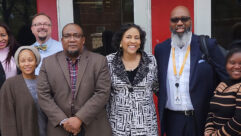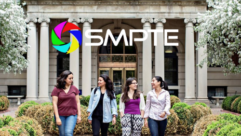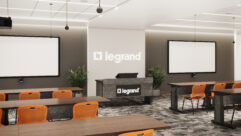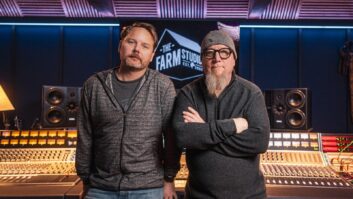LONDON and BERLIN — 9 June 2015 — The Society of Motion Picture and Television Engineers(R) (SMPTE(R)), a leader in motion-imaging standards and education for the communications, media, entertainment, and technology industries, partnered with the Fernseh- und Kinotechnische Gesellschaft (FKTG), in collaboration with the EBU’s Technology and Innovation department, to hold the SMPTE Forum 2015, “Entertainment Technology in the Internet Age: A European Perspective,” in Berlin. Hosted 7-8 May by the Fraunhofer Institute, the event attracted industry leaders for discussion and debate about the evolution and future of internet-based media delivery and consumption across Europe.
“During the SMPTE Forum 2015, we covered a great deal of ground, delving into topics and technologies whose future is exciting, even if uncertain,” said Dr. Hans Hoffmann, ETIA program committee chair and head of media fundamentals and production technology at the EBU. “Internet-delivered content plays a central role in a quickly growing array of compelling applications, in and beyond the world of entertainment. The SMPTE Forum 2015 afforded attendees a unique opportunity to hear from key players behind the continuing advance of content delivery in Europe from a technical or business perspective, as well as from a creative standpoint.”
Chris Fetner, director of global content partners operations at Netflix, opened the first day of sessions with a keynote address on the state of internet entertainment in Europe. The need for efficiency in content delivery was a primary focus of his speech, and Fetner stated that the industry needs open standards — such as SMPTE’s Interoperable Master Format (IMF), which Netflix has adopted in order to realise key efficiencies — if it is to continue innovation for the next century.
A subsequent panel on the creation and distribution of entertainment content for the web repeated the notion of standards. SMPTE Education Vice President Pat Griffis, also of Dolby, moderated a panel that included Robert Amlung of ZDF, Anil Kokaram of Google/YouTube, and Simon Fell of the EBU, who together reiterated that industry standards are necessary for the successful conversion between linear and nonlinear content distribution. Though over-the-top (OTT) content now represents just 2 to 3 percent of overall viewing, ongoing growth will force broadcasters to invest in technologies that support OTT delivery. While content remains king, the current challenge is to deliver quality images via the internet in a cost-effective way.
SMPTE Governor Richard Welsh, CEO of Sundog Media Toolkit, moderated a session on preserving the artistic intent to the consumer. A live demonstration by Touradj Ebrahimi, professor at Swiss Federal Institute of Technology in Lausanne (EPFL) and current convener of the JPEG committee, demonstrated tools that allow creators and artists to change the centre of focus on a given image, depending on the story’s intended direction, before it is delivered to the consumer. The session also addressed virtual reality (VR) as a tool for creative storytelling. Panelists discussed viewer screen size and processing power as challenges that must be addressed before such tools become mainstream.
Thomas Staneker, head of the international TV technical service centre at Deutsche Telekom, gave his keynote address on day two, and spoke of the need to harmonise technology across Europe, despite the different content types being delivered. Staneker predicted that, by 2020, television would be produced and distributed in the cloud from a central data centre. He advised broadcasters to “keep calm and start running” and to remain proactively engaged as the industry evolves.
Later in the day, Andrew Perkis of the Norwegian University of Science and Technology moderated a session dedicated to VR via the web. Two experts in VR provided examples of the research they are conducting and the reaction among viewers. Mel Slater, professor at ICREA-University of Barcelona, gave examples of how people are responding to VR, and Doron Friedman of the Sammy Ofer School of Communications discussed how VR can enable interactive storytelling, and possibly even digital time travel.
Siegfried Foessel of Fraunhofer IIS, and FKTG chairman, moderated a session that included Bernhard Grill, also of Fraunhofer IIS, and Matthieu Parmentier of FranceTV, who discussed the recent developments in audio for the web. Grill explained the different immersive systems, including object-based audio systems, while Parmentier discussed challenges in production and distribution, the impact of metadata, and audio-rendering engines.
Kokaram hosted a session on translating traditional content for the web, during which Todd Prives of Google spoke to the use of cloud rendering solutions and their likely adoption for feature film production. Derek Buitenhuis of Vimeo explored the myriad open source tools being used for rendering and transcoding content, emphasising the need for open standards that can keep pace with the proliferation of toolsets being developed. In addition to stating that the most-watched video is the buffer spin, Renganathan Ramamoorthy of Chrome Media at Google spoke of the need to use adaptive bit rates, despite the fact that there are trade-offs and behaviour differences separating Europe and the United States.
Additional session discussions examined EU and U.S. regulatory environments, the fundamentals of hybrid broadcast broadband TV (HbbTV), techniques for preserving artistic intent when delivering content over the internet, and how social media plays a role in entertainment media.
Further information about SMPTE is available at www.smpte.org. Further information about FKTG is available at www.fktg.org.
# # #
About the Fernseh- und kinotechnische Gesellschaft FKTG e.V.
The FKTG e.V. is one of the oldest professional technology associations in Germany, founded by two predecessor organizations, the German Cinema Technology Association (DKG, founded in 1920) and the Television Technology Association (FKT, founded in 1952). The main objective of the FKTG is to provide information on developments for television and cinema technology to all engineers and all people working as scientists or technologists in the field of television and cinema, and to provide a platform for exchange of knowledge and experience.
More than 110 supporting international companies and nearly 2,000 persons are members of the FKTG, which is the largest network of its kind in the German-speaking area of Europe. The FKTG hosts conferences and technology workshops in different local regions on a regular basis and supports further scientific education through its network of more than 50 universities and advanced technical colleges in Germany, Austria, and Switzerland. More information about FKTG and how to join is available at www.fktg.org.
About the Society of Motion Picture and Television Engineers(R) (SMPTE(R))
The Oscar(R) and Emmy(R) Award-winning Society of Motion Picture and Television Engineers(R) (SMPTE(R)), a professional membership association, is a leader in the advancement of the art, science, and craft of the image, sound, and metadata ecosystem, worldwide. An internationally recognised and accredited organisation, SMPTE advances moving-imagery education and engineering across the communications, technology, media, and entertainment industries. Since its founding in 1916, SMPTE has published the SMPTE Motion Imaging Journal and developed more than 800 standards, recommended practices, and engineering guidelines.
More than 6,000 members — motion-imaging executives, engineers, creative and technology professionals, researchers, scientists, educators, and students — who meet in Sections throughout the world sustain the Society. Through the Society’s partnership with the Hollywood Professional Alliance(R) (HPA(R)), this membership is complemented by the professional community of businesses and individuals who provide the expertise, support, tools, and infrastructure for the creation and finishing of motion pictures, television programs, commercials, digital media, and other dynamic media content. Information on joining SMPTE is available at www.smpte.org/join.
All trademarks appearing herein are the property of their respective owners.
Photo Link:www.wallstcom.com/SMPTE/SMPTE-NetflixsChrisFetnerandSMPTEExecutiveDirect…
Photo Caption: Netflix’s Chris Fetner and SMPTE Executive Director Barbara Lange
Photo Link: www.wallstcom.com/SMPTE/SMPTE-Forum2015Partners.jpg
Photo Caption: (l-r) Hans Hoffman of EBU; Juergen Burghart CEO of FKTG; Pat Griffis, SMPTE Education Vice President; Dr. Rainer Schaefer, Vice President of FKTG; Barbara Lange, SMPTE Executive Director; and Siegfried Foessel, FKTG President
Photo Link: www.wallstcom.com/SMPTE/SMPTE-GroupofSMPTEForumDelegates.jpg
Photo Caption: A Group of Forum Delegates










